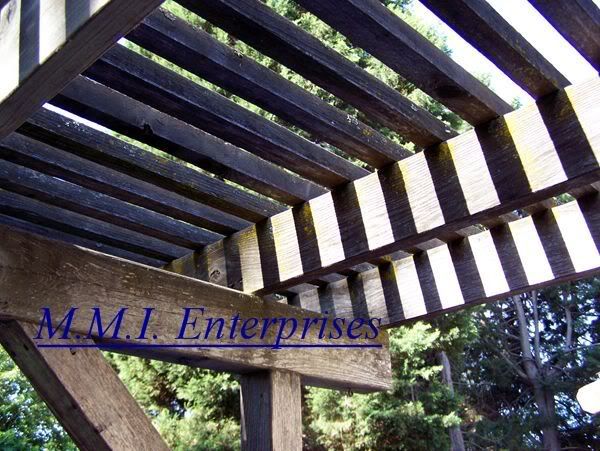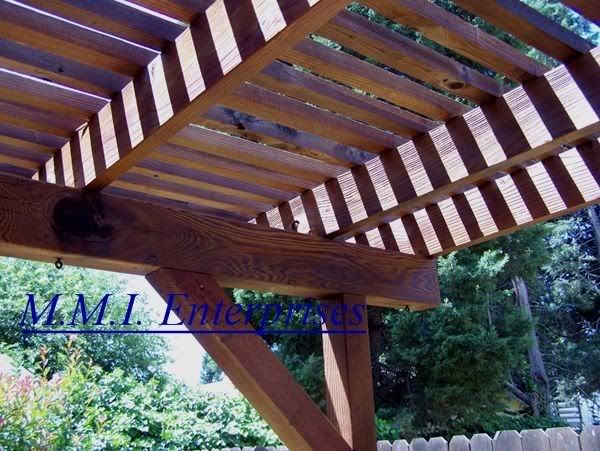-
Content count
3,057 -
Joined
-
Last visited
-
Days Won
5
Posts posted by MMI Enterprises
-
-
Finished this pita job today.... Does anyone enjoy doing pergolas or arbours?
My arms are way sore from monkeying all over it. :) . Takes longer then doing a deck...maybe as long as a raised deck. Likely should have been priced that of a deck that for sure but I gave the guy a break.





-
Most folk don't want to risk strong chems going through their pumps via upstreaming as they believe it hurts the packings.. I would tend to agree, better be safe then sorry.
Design and sales of equipment for to upstream weaker chems is common though.. i.e- Hotsey
P.S.- I think maybe the bypass is reverted to either a float tank or after the float tank in a small simple loop.
-
:2eyes: What??..that don't sound right...bypass is before downstreamer aint it?
-
I just mixed my first gallon of the year of my famous wood pre-tratment that uses raw linseed oil as its main ingredient. And the stirring rod I used mix it with is totally dry! And no mildew will grow on this stuff!Am interested in where your getting it as well as brand, etc...
Raw flax seed oil drying that quik don't sound raw to me. Is supposed to take days if not weeks..
-
Larry,
With 12% Apple Sauce recipe starts at 3.6% mixed -- .036x5gal/.12=1.5gal
...and goes upto 5%--- .05x5gal/.12= 2 gal.
It is for roofs and I think some say ya can go upto 6% or so on them.
On housewashes though the consensus is to not go over 4%..
The math formula above in my other post is real fast and you can't go wrong with it..
for apple sauce with 10%:
.036 5 gal .18
1 X .10 = .10 = 1.8 GAL.
-
Ok Daniel, I have found a most important website link for you to review. Maybe it will help to define the recipe items more discretly:
Boiled (a term for mixing raw oil, solvents, driers) = fast dry
Bodied (actually boiled oil) = not so fast :)
-
The alkyd (resin,binder) is a product in and of itself made by reactive processes. As I understand it, it is supplied to the paint/stain manufactures and they then perform their formulations/mixes which include it. It's properties as stand alone product don't dictate it as fast drying. The overall speed of the mix curing out is probably some average between the recipe items or what they allow of each other. In viewing the recipe items as individuals stuck in their specific chemical state a manufacture or tweaker can hopefully arrive at a product with all the qualities they and we are after.
"I thought that a bodied linseed oil is already polymerised in the can, would only have to wait for the spirits to leach out and then it is automatically cured." Stand oil is product in and of itself and is polymerized yes but not cured which is by means of chemical oxidation. It is a recipe item.
-
Russell have you ever considered going from a 'boiled' linseed oil that uses dryers, to a fully polymerised 'bodied' linseed oil? If I understand this correctly the old oil based primers use to be a mixture of Raw linseed oil and bodied linseed oil - since there are no dryers present in the 'Bodied' linseed oil - the Raw linseed oil was free and unperturbed to dive deep into the wood without being corrupted by dryers present in the 'boiled' linseed oil. So once the spirits where evaporated - you already had a cross-linked surface layer.Daniel, There is some confusion..I'll try to help...
Boiled refers to mix of raw oil, solvents which can be of varying speed, and driers...drys faster..
Bodied refers to raw oil heated without oxygen present to thicken and polymerize hence the implied term that it has more body. It will not help another consistancy oil dive deeper. In case of bodied linseed oil... they dry slower then boiled and they are called 'stand oil'. It's use is to thicken oil mixes and give durability properties. This heating act/polymerization is known as crosslinking which makes a finish durable and solvent resistant and but far as I know doesn't make for neither a faster 'surface' cure or a faster 'through' cure. The term cure means and comes by way of evaporation of the solvent initially and then mainly oxygen uptake (oxydation) creating a reaction (causes heat btw)that turns the oil into a solid composed of a totally different chemical makeup. This fully completed process relates to the general or full curing time. The term 'stand' has two fold meaning in that such oil stands up (has body) or that such oil stands up (has durability). :) . In a sense perhaps you can now see that the resultant thicker/polymerized/crosslinked particles are suspended in a medium and are not really more so on their way to being cured persay... (such is also done in acrylic water based finish).
Another way to thicken an oil is to blow it which is act of passing warm to hot air through it....Forgive if this is not totally accurate as it is late and I am not a chemist.
You can gleam all this from readily available websites like wikipedia or sites dedicated to oil paintings if you really study hard. This one not bad: Tung & Linseed Oils
(note how tung will be faster if bodied in general)
-
Russell have you ever considered going from a 'boiled' linseed oil that uses dryers, to a fully polymerised 'bodied' linseed oil? If I understand this correctly the old oil based primers use to be a mixture of Raw linseed oil and bodied linseed oil - since there are no dryers present in the 'Bodied' linseed oil - the Raw linseed oil was free and unperturbed to dive deep into the wood without being corrupted by dryers present in the 'boiled' linseed oil. So once the spirits where evaporated - you already had a cross-linked surface layer.Daniel, There is some confusion..I'll try to help...
Boiled refers to mix of raw oil, solvents which can be of varying speed, and driers...drys faster..
Bodied refers to raw oil heated without oxygen present to thicken and polymerize hence the implied term that it has more body. It will not help another consistancy oil dive deeper. In case of bodied linseed oil... they dry slower then boiled and they are called 'stand oil'. It's use is to thicken oil mixes and give durability properties. This heating act/polymerization is known as crosslinking which makes a finish durable and solvent resistant and but far as I know doesn't make for neither a faster 'surface' cure or a faster 'through' cure. The term cure means and comes by way of evaporation of the solvent initially and then mainly oxygen uptake (oxydation) creating a reaction (causes heat btw)that turns the oil into a solid composed of a totally different chemical makeup. This fully completed process relates to the general or full curing time. The term 'stand' has two fold meaning in that such oil stands up (has body) or that such oil stands up (has durability). :) . In a sense perhaps you can now see that the resultant thicker/polymerized/crosslinked particles are suspended in a medium and are not really more so on their way to being cured persay... (such is also done in acrylic water based finish).
Another way to thicken an oil is to blow it which is act of passing warm to hot air through it....Forgive if this is not totally accurate as it is late and I am not a chemist.
You can gleam all this from readily available websites like wikipedia or sites dedicated to oil paintings if you really study hard. This one not bad: Tung & Linseed Oils
(note how tung will be faster if bodied in general)
-
watering down and spreading things out is what we do best. It has bennefits...it makes people have to work for things and keeps us busy..lol
-
Ken, Are you serious? Nobody is saying anything out of the ordinary. Nothing wrong with this job being done with various chems or methods outside your current business plan. There are only two of us here mentioning other chems other then hydroxide so I assume your head banging is over Ricks danger ridden example of why not to use it. Granted you can dilute it to be about harmless but really why go there? I see no past evidence of stain or sealer.(am interested of course in What Rod sees..do share Rod)
Fact is your right about efficiency but only in respect that it perhaps be more likely that a stronger mix of S/H would end up getting applied due to stronger starting strength prior to mixing and therefore the gray more likely to be removed quiker. Stain removal/bleaching is just as, or more likely, with the percarb or percarb mix then s/h alone. If applied strengths/effective cleaning power are made equal I would rather use the percarb any day. Thing is the percarb mix only lasts part of a day so maybe that part of why many like to use whether the wood needs it or not.
Personally the percarb runs a little cheaper for me.With that said I am not really recommending percarb alone..as you likely know I kinda like the 'modified apple sauce'..
For sake of example of dilution and trivia.... hydroxide is brushed on pretzels to make the outside crisp.. :)
Here is another thing to consider here on this project... this project could likely turn out just fine with oxalic alone..
Speaking of oxalic...am interested in what % strength you shoot for in your chem tank prior to downstreaming. Does it disolve for you guys well in cold water or no?. I been using citric and but last time I used the oxalic the cold water didn't work so well... Figures I came up with based on 20% (5:1)downstreamer is that to be equal with standard straight spray on (6oz.) is that you would need to have 23.43% (30oz) mix per gal. Is that correct?..
-
Oh and it don't matter cause Baker's is supposed to be the bomb..haha..
-
Yup..that what I said just in different words :)
I'm glad you understand it....,haha...
The 1) reason is right on..I doubt the theory of 2) though.
With that under our belt I double dare ya to sand a deck to about 400 and then stain. There won't be issue I suspect. All the times I've done interior wood pieces as such I never noticed traffic related wear issues. I mean tables usually don't get much traffic but gun stocks do. ...
Hey in thinking about it ya think it possable them folks just washed that deck too much?
-
He know not what kind of can of worms he put in everyones face do he???..:)
-
DSing is as it implies means your streaming chemical downstream of the pump.. so your not likely to hurt anything.
The DSer with machine powering it's venturi will dilute chems for you. Depending how strong you need you can dilute the chem first into a mix bucket or like Ken perhaps means to say you can just drop your DS line into a straight bucket of chemical and let the DS and it's adjustment valve do the work of ratios for you.(upto about 20%). There are other methods using small dedicated pumps to force feed the DSer more chem to improve your ratio if ya like.
-
Kevin, its more a question of efficency. While you are pulling out and setting up a pump, I would have dipped a hose into a premixed tank of stripper and have that whole deck coated in under three minutes. It would be drenched with plenty of moisture and a diluted mix so furring would not be an issue. While you are stirring up your percarb mix, we are already washing which might take another 25 minutes including the trellis. While you are cleaning out your pump to start applying acid I am already applying it via downstream at the same rate of 2-3 minutes for a total coat. When you are once again cleaning the acid from your pump and start rolling it towards your rig, we are already on the road headed to the next job.That whole thing should be cleaned and balanced in less than an hour from roll up to drive away.
Ken.... My belief is that number one goal firstly should be to not do more then needed to get the wood to condition to stain or seal and to not harm customers property... Mixing percarb powder takes no longer then hydroxide flakes but I hear what yer saying in that your using concentrated liquid form. Not sure discussing methods of application or efficiency plays part of the decission to be made here...I don't know how he goes about applying things and apparently you perhaps assume too much on how I would go about it but here I'll tell you I have most all methods of application dreampt up. Not gonna get too much into except for saying that ALL my cleaning/stripping/neutralizing application equipment stays in trailer and I currently can put out over 4gpm straight chemical if I wish through either my main pressure hose or dedicated 5/8 hose so I am right there with ya :)
-
Scott, been watching Mythbusters?....They did that with all sorts of items...Forget which item was meant to be tested to see if it would kill ya but things like paint cans, hammers, and 5 gal buckets will apparently do ya in too....:bullistic:
-
A little in contrast here but I don't see it needing hydroxide...but hey I am just a newbie..... Why take the chance of furring it when this will turn out like new if just percarbed and then oxalic neutralized??.. I say oxalic as I would want them nail bleeds gone...
-
Kevin,They are fiber 3M defelting pads, I don't know, maybe 12" in diameter? Used on a Makita 9227C polisher, that rotates at setable RPM.
Maybe "burnishing" is the wrong word. But generated heat from overuse was probably a problem, especially with cedar. Net effect was like a high grit sanding. The paraffinic oil went into the cedar fine, but the resins and pigments at the surface lost their "grip" in areas after about 9 months.
Oh sorry Rick. I misread that ya had used pads.....You have the right word though in 'burnishing' if you were spinning fast enough to create heat. (maybe 1k rpm on up). Polishing is via abrasive or grit and burnish is via heat producing friction. In floor care I run the spectrum in using both abrasion and friction to create gloss..have used literally hundreds of models of pads by various manufacture.. is a fine art....basically for defelting it should be best to stay away from anything that can load up..open weave good, thermal pad bad...
I want to get this straight with you though...You saying when you did what you did you got just as much stain into the wood in the effected areas and it was the wood being too smooth or slick that caused failure?... You like somewhere around 100 grit smoothness I take it?
I can't really picture too smooth wood causes failure less it be a film forming sealer but can picture case where burnishing sealer or natural wood resins could cause less penetration of RS type products.
-
"Peirce figures it out. We "burnished" the cedar, in other words hitting the cedar very hard by going through that many defelting pads was like sanding at 200 grit."
In other words using worn out/loaded sand disks can result in heat burnishing the old sealers into the wood poors that much deeper resulting in less stain absorbsion..... burnishing is my gig on hard flooring.. :)
-
just straps or turnbuckles in the pallet holes.. it aint going no where...they don't bolt them when they ship the original chems around in them. They use them all over the place out here in the oil industry. I have pallet jack and drop leaf axle on my little trailer and plan to get one of them one of these days for a C note.
-
Especially the "b,e,h,s" ' s. If it were just a tad less exagerated it be good. Thaz what I am gonna do..might even use that awesome deck picture..lol j/k...oh but really you send me that in high res ok? :)...haha... yea seriously.. you do that.. :) :)
-
This is small and simple..
Buy one of them 14-16" window brushes, an adjustable angle sqweegie, a simple broom type wooden pole or fancy extension one if ya like, a 5 gal bucket, a bottle of dawn, and a half dozen bottles of mountain berry Windex.
A bottle of windex and a squirt of dawn will do fine.
Don't overwet the wash brush..just stick in half way or so in bucket. Wash the top layer of windows keeping away from left edge and top edge. Then take your angled sqweegie and run it horizontal. After each swipe you rag dry the top half of sqweegie.(just a few inches really). Then rag the right edge and the bottom edge of each window like Rich said with pole. Now move onto the lower windows by hand without pole. You can use a window washers figure eight pattern and make short work of it with both the washer and sqweegie....Maybe be about $50 supplies to get started....historically a pane is something between $1 and $2 a side but these are all small so...
-
Nice to see some Cali folk around even if they are over there by them leftist libs... :)



Porch Pergola equals PITA
in Wood Cleaning & Restoration - Decks, Fences, etc.
Posted · Report reply
Yea that be pure pita factor too..can't imagine one not being.. :)
I was not shy with the tarps for windows and walls (mainly to protect during cleaning) and I was fully suited up with face respirator during cleaning and staining both. Felt no need to protect concrete below since I use HVLP properly adjusted..I would never want to do this type job without full on atomization.
p.s.-and about the sq. footage..when I first eyeballed it I thought it 15'x10'..It was 20x12=240. This one I did with the 2x2's should probably be priced x3 considering the two sides and the joists. Ya think that one you did would be about x2 since there be only joist?